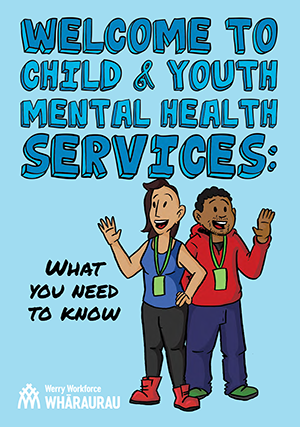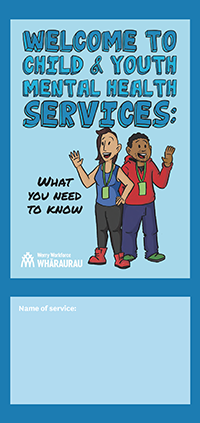
CAPA Choice
CAPA Choice
CAPA encourages early face-to-face contact, family/whānau involvement and client self-determination.
This early (or first) face-to-face contact with the service is called the Choice Appointment.
This section aims to clarify the intent and necessary steps of a Choice Appointment; provide resources and support the learning of core skills and knowledge required to undertake a Choice Appointment.
Click on the tab headings below to view resources.
This guide aims to clarify the intent and necessary steps of a Choice Appointment as implemented under CAPA. It describes the philosophy of Choice and provides a framework to support the learning of core skills and knowledge required to undertake a Choice Appointment. The guide is intended for new clinicians, clinicians who are new to CAPA and Choice Appointments and can also be used by teams looking to have a consistent CAPA approach to care. Using a guide for Choice Appointments encourages a stance of continuous clinical practice improvement.

A component of the Choice and Partnership Approach is the CHOICE appointment. This e-learning course will support you to develop tamariki and whānau centred services that are accessible and offer choices.
We encourage the use of this PowerPoint for teaching sessions within teams. For further assistance with training sessions, please contact the CAPA project manager.
CAPA Service User 'What you need to know' (Resources)
This resource has been developed with young people to help explain the journey through a CAPA CAMHS service.
• What you need to know (comic version)
This template has been designed to assist communications teams with developing a resource for young people to explain the journey through a CAPA CAMHS service. Services can use this template and add in additional logos as required.
• What you need to know (template)
These templates have been developed to enhance the service experience. The templates have been designed to encourage clinicians to move away from traditional letter writing post Choice appointment.
Currently we have two versions available – we welcome your feedback on these.
How do these templates work?
- Templates have been designed to be populated during the Choice appointment.
- At the conclusion of Choice, the populated template is then photocopied, one copy for your records, additional copies for referrers, the original to the young person and family/whānau to take away.
The benefits of using Choice templates
- Less time spent doing admin – information is captured during the Choice appointment
- Less medical jargon – medical jargon can be confusing for families to understand
- Referrers often don’t have time to absorb vast amounts of content - the template helps to stick to the most important matters
- Empowerment of the young person and family/whānau
- Reduced risk of young person and family/whānau disconnecting from the process
- Less opportunity for information to be lost or misinterpreted in translation
Download:
- Choice Appointment Form
- Choice Appointment Summary
- How to write an inviting choice letter to rangatahi and whānau
These templates can be edited to suit individual service requirements – for further information on this please contact the CAPA Project Manager.
Choice and Partnership within a wellbeing programme in primary schools in Canterbury
The Mana Ake initiative is a collaboration between the Ministry of Health, the Ministry of Education and Canterbury DHB, Police, non-government organisations and consumers, facilitated by the Canterbury Clinical Network. The Canterbury Clinical Network leads its design and implementation. Mana Ake kaimahi work with schools to support teachers, families and whānau when children are experiencing ongoing issues that impact their wellbeing such as anxiety, social isolation, parental separation, grief and loss and managing emotions.
Kaimahi have a diverse range of skills and include psychologists, social workers, nurses, counsellors, teachers and youth workers. Kaimahi provide interventions for children and their families/whānau at school, in the community or at home. The practice framework is built on the principles of Choice and Partnership, the assessment process being guided by a Choice framework. Next steps may include continued engagement with the child and their family/whānau, assessment and intervention delivered by the worker and the Mana Ake Team; collaboration and support in the school environment; collaboration and support in the local community.
- Read the Mana Ake Assessment
SACS ABC and CAPA - Substances and Choices Scale (SACS ABC) as part of Choice.
- As part of the Choice appointment, every young person aged 13 and above is required to have the SACS screening tool completed.
- Completing the SACS screening tool assists with understanding the young person’s AOD use. The results are then able to be factored into their treatment plan, Partnership and determine whether there is a need for referral to specialist AOD service.
- SACS helps to ensure that ‘any door is the right door’ for young people accessing treatment for substance use issues.
What is SACS?
- A one-page self-report questionnaire you do with a young person.
- Designed and tested in kiwi youth
- Screens AOD use and related harms, problems and risks
- Engages young people to think & talk about their substance use
- Scores the young person's responses to let them & you know where they sit compared to other kiwi youth.
- Designed to aid in the provision of feedback, brief AOD advice and referring on when warranted
- Increases engagement in referral vs screening alone
What is the SACS ABC approach?
SACS has been adapted specifically for brevity and to align with the well-known ABC approach for smoking cessation and alcohol. Based on The SACS Brief Intervention (see www.sacsinfo.com). The resources incorporate the Substances and Choices Scale (SACS), a youth AOD (alcohol and other drug) screening instrument developed and tested in New Zealand (Christie et al., 2007). SAC ABC is a resource for youth mental health and addiction workers, designed and promoted by the Werry Workforce Whāraurau (Christie, 2010).
A: Ask – Administer SACS Screening, review and score
B: Brief Advice – Deliver Feedback and brief advice
C: Counselling – Referral for Counselling /Treatment
A simple and effective easy memory aid to screen youth for problematic AOD use and provide brief personally-relevant AOD interventions
SACS ABC Brief Intervention Manual
Benefits of using SACS screening tool in Choice appointments
SACS aims to improve short and long term outcomes for young people with AOD problems by providing a quick and easy brief screening tool within ICAMHS. The outcome of completing the SACS screening tool can lead to the young person receiving a brief intervention, supporting a harm reduction approach and the ability to have access to the right partnership or services if needed.
This SACS ABC video demonstrates utilising the SACS Brief Intervention with a young person. This clip illustrates how to utilise the SACS Brief Intervention tool. It should be watched in conjunction with the resources and information available here.
The Drive series of video resources are designed to help young people and their families navigate their way through child and adolescent mental health services. These can be used with the young person and their family/ whānau following Choice and within Partnership. The videos show examples of different kinds of therapies and clinicians who work in these services. They also include information about medications that are sometimes used to treat anxiety, depression and psychosis. Each video is around 5 minutes duration.




